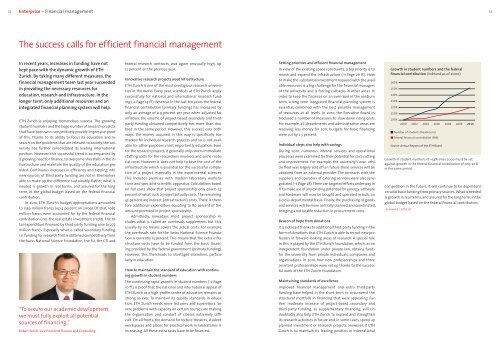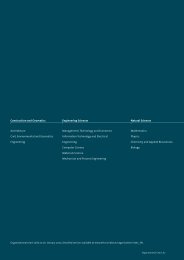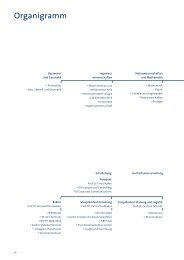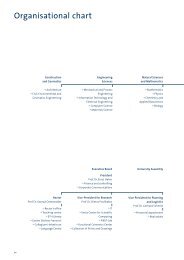ETH ZuricH - ETH - Finanzen und Controlling - ETH Zürich
ETH ZuricH - ETH - Finanzen und Controlling - ETH Zürich
ETH ZuricH - ETH - Finanzen und Controlling - ETH Zürich
You also want an ePaper? Increase the reach of your titles
YUMPU automatically turns print PDFs into web optimized ePapers that Google loves.
32 Enterprise – Financial management<br />
33<br />
The success calls for efficient financial management<br />
In recent years, increases in f<strong>und</strong>ing have not<br />
kept pace with the dynamic growth of <strong>ETH</strong><br />
Zurich. By taking many different measures, the<br />
financial management team last year succeeded<br />
in providing the necessary resources for<br />
education, research and infrastructure. In the<br />
longer term, only additional resources and an<br />
integrated financial planning system will help.<br />
<strong>ETH</strong> Zurich is enjoying tremendous success. The growing<br />
student numbers and the huge number of research projects<br />
that have been won competitively provide impressive proof<br />
of this. Thanks to its ability to focus its education and research<br />
on the problems that are relevant to society, the university<br />
has further consolidated its leading international<br />
position. However, this successful trend is accompanied by<br />
a growing need for finance, to overcome shortfalls in the infrastructure<br />
and maintain the quality of the education provided.<br />
Continuous increases in efficiency and tapping into<br />
new sources of third-party f<strong>und</strong>ing are not in themselves<br />
able to make up the difference sustainably. Rather, what is<br />
needed is growth in real terms, and assured for the long<br />
term, in the global budget based on the federal financial<br />
contribution.<br />
In 2010, <strong>ETH</strong> Zurich’s budget appropriations amounted<br />
to 1359 million francs (up 4 percent on 2009). Of that, 1082<br />
million francs were accounted for by the federal financial<br />
contribution (incl. the real estate investment credit). The total<br />
expenditure financed by third-party f<strong>und</strong>ing rose to 277<br />
million francs. Especially what is called secondary f<strong>und</strong>ing,<br />
i.e. f<strong>und</strong>ing for research that is obtained competitively from<br />
the Swiss National Science Fo<strong>und</strong>ation, the EU, the CTI and<br />
“To secure our academic development,<br />
we must fully exploit all potential<br />
sources of financing.”<br />
Robert Perich, Vice President Finance and <strong>Controlling</strong><br />
federal research contracts, was again unusually high, up<br />
12 percent on the previous year.<br />
Innovative research projects need infrastructure<br />
<strong>ETH</strong> Zurich is one of the most prestigious research universities<br />
in the world. Every year, scientists at <strong>ETH</strong> Zurich apply<br />
successfully for national and international research f<strong>und</strong>ing<br />
(Y Page 14 ff.). Whereas in the last ten years the federal<br />
financial contribution (primary f<strong>und</strong>ing) has increased by<br />
only an average of 0.9 percent per year when adjusted for<br />
inflation, the volume of project-based secondary and thirdparty<br />
f<strong>und</strong>ing obtained competitively has more than doubled<br />
in the same period. However, this success cuts both<br />
ways: the money acquired in this way is specifically earmarked<br />
for individual research projects and so is not available<br />
for other purposes, most importantly education. Even<br />
for the research projects, it generally only covers immediate<br />
staffing costs for the researchers involved, and some material<br />
costs. However, it does not help to bear the cost of the<br />
infrastructure which is essential for the successful completion<br />
of a project, especially in the experimental sciences.<br />
This includes premises with modern laboratory workstations<br />
and specialist scientific apparatus. Calculations based<br />
on full costs show that project sponsorship only covers 55<br />
percent of what such a project actually costs. The remaining<br />
45 percent are indirect (infrastructure) costs. There is therefore<br />
additional expenditure equating to 80 percent of the<br />
amount promised in project sponsorship.<br />
Admittedly, nowadays most project sponsorship includes<br />
what is called an overheads supplement, but this<br />
usually by no means covers the actual costs. For example,<br />
the overheads rate for the Swiss National Science Fo<strong>und</strong>ation<br />
is currently 15 percent. This means that the extra infrastructure<br />
costs have to be f<strong>und</strong>ed from the basic financing<br />
provided by the federal government (primary f<strong>und</strong>ing).<br />
However, this then leads to shortages elsewhere, particularly<br />
in education.<br />
How to maintain the standard of education with continuing<br />
growth in student numbers<br />
The continuing rapid growth in student numbers (Y Page<br />
10 ff.) is proof that the national and international appeal of<br />
<strong>ETH</strong> Zurich as a high-profile centre of education remains as<br />
strong as ever. To maintain its quality standards in education,<br />
<strong>ETH</strong> Zurich needs more lecturers and supervisors. Severe<br />
problems with capacity on certain courses are making<br />
the organisation and conduct of classes extremely difficult.<br />
On all fronts, the demand for lecture theatres, student<br />
workspaces and places for practical work in laboratories is<br />
increasing. All these extra tasks have to be financed.<br />
Setting priorities and efficient financial management<br />
In view of the existing space constraints, a top priority is to<br />
renew and expand the infrastructure (Y Page 26 ff.). How<br />
to make the substantial investment required with the available<br />
resources is a big challenge for the financial managers<br />
of the university and is forcing cutbacks in other areas. In<br />
order to keep the finances on an even keel in the medium<br />
term, a long-term integrated financial planning system is<br />
essential, combined with the best possible management<br />
of resources at all levels. In 2010, the Executive Board introduced<br />
a number of measures to slow down rising costs.<br />
For example, all departments and administrative areas are<br />
receiving less money for 2011; budgets for basic financing<br />
were cut by 2.5 percent.<br />
Individual steps also help with savings<br />
During 2010, numerous internal services and operational<br />
processes were examined for their potential for cost-cutting<br />
and improvement. For example, the university’s own vehicle<br />
fleet was largely sold off; in future these services will be<br />
obtained from an external provider. The contracts with the<br />
suppliers and operators of catering services were also renegotiated<br />
(Y Page 28). There are targeted efforts <strong>und</strong>erway in<br />
IT to make use of any existing potential for synergy: software<br />
and hardware will now be bought and operated in bulk, on<br />
a cross-departmental basis. Finally, the purchasing of goods<br />
and services will be more centrally planned and coordinated,<br />
bringing a noticeable reduction in procurement costs.<br />
Beacon of hope from donations<br />
It is not least thanks to additional third-party f<strong>und</strong>ing in the<br />
form of donations that <strong>ETH</strong> Zurich is able to recruit new professors<br />
in forward-looking areas of research. A special role<br />
in this is played by the <strong>ETH</strong> Zurich Fo<strong>und</strong>ation, which, as an<br />
independent fo<strong>und</strong>ation <strong>und</strong>er private law, obtains f<strong>und</strong>s<br />
for the university from private individuals, companies and<br />
organisations. In 2010, four new professorships and three<br />
assistant professorships were set up thanks to the successful<br />
work of the <strong>ETH</strong> Zurich Fo<strong>und</strong>ation.<br />
Maintaining standards of excellence<br />
Improved financial management and extra third-party<br />
f<strong>und</strong>ing have helped in the short term to circumvent the<br />
structural shortfalls in financing that were appearing. Further<br />
moderate increase of project-based secondary and<br />
third-party f<strong>und</strong>ing, as supplementary financing, will <strong>und</strong>oubtedly<br />
also help <strong>ETH</strong> Zurich to expand and strengthen<br />
its research activities in future and, in some cases, speed up<br />
planned investment or research projects. However, if <strong>ETH</strong><br />
Zurich is to maintain its leading position in international<br />
Growth in student numbers and the federal<br />
financial contribution (indexed as of 2000)<br />
160%<br />
150%<br />
140%<br />
130%<br />
120%<br />
110%<br />
100%<br />
Number of students (headcount)<br />
Federal financial contribution (FBB)<br />
Growth in student numbers of +53% since 2000 must be set<br />
against growth in the federal financial contribution of only 20%<br />
in the same period.<br />
competition in the future, it will continue to be dependent<br />
on solid basic f<strong>und</strong>ing from primary sources. What is needed<br />
is growth in real terms, and assured for the long term, in the<br />
global budget based on the federal financial contribution.<br />
Y www.fc.ethz.ch<br />
2000 2002 2004 2006 2008<br />
Source: Annual Reports of the <strong>ETH</strong> Board<br />
2009 2010
















![DFC Newsletter Ausgabe 2006/09 September [Deutsch] (PDF, 103 kB)](https://img.yumpu.com/38538463/1/184x260/dfc-newsletter-ausgabe-2006-09-september-deutsch-pdf-103-kb.jpg?quality=85)